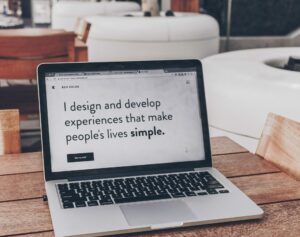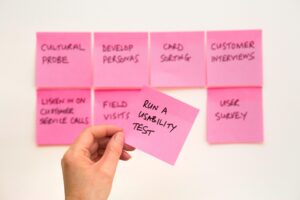User experience (UX) design focuses on creating meaningful and satisfying interactions between users and digital products or services. It encompasses various aspects, including research, design, usability, and functionality.
UX designers strive to understand user needs, behaviors, and preferences to design intuitive interfaces and optimize the user journey.
They employ techniques like user research, wireframing, prototyping, and usability testing to enhance user satisfaction and usability.
Ultimately, UX design aims to create seamless and enjoyable experiences that meet user goals and foster positive perceptions of the product or service. Let us look into UX objectives, fundamentals, and the designing process in this comprehensive guide!
What Is the Objective of UX Design?

Before we learn about the designing process, it’s crucial for us to understand the objective of UX design, as it can help us create interactive digital experiences!
UX design is of utmost importance as it directly impacts the success of businesses. It focuses on creating enjoyable, efficient, intuitive experiences for users interacting with digital products or services.
By prioritizing user needs and preferences, UX design enhances customer satisfaction, encourages repeat visits, and fosters brand loyalty.
A well-designed UX reduces friction, improves usability, and increases conversions, ultimately driving business growth. It helps businesses stand out from competitors, establishes credibility, and boosts customer engagement.
By investing in UX design, businesses can create positive and memorable experiences that resonate with users, leading to increased user retention, positive word-of-mouth, and long-term business success.
What Makes a Great User Experience?

Several key elements characterize a good user experience.
- Meeting user needs: Firstly, a good user experience focuses on meeting user needs and goals effectively and efficiently.
A well-designed UX anticipates user expectations and provides intuitive navigation, clear information hierarchy, and smooth interactions. It prioritizes simplicity, minimizing complexity and cognitive load.
- Appealing aesthetics: Aesthetics also play a role, with visually appealing designs enhancing user engagement.
- Hooking the audience: A good user experience goes beyond meeting basic functionality.
It goes the extra mile to create an emotional connection with users. This involves understanding and catering to their desires, aspirations, and motivations.
- Evoking emotions: A good UX design evokes positive emotions, such as joy, delight, and trust, through carefully crafted interactions, micro-interactions, and visual aesthetics.
- Consistency: It pays attention to details, ensuring consistency across the entire user journey.
- Seeking user input: Great user experience also values user feedback and actively seeks user input to continuously improve and refine the experience.
Key Elements of UX Design in 2023
By focusing on usability and emotional impact, a good UX leaves a lasting impression, builds brand loyalty, and drives user advocacy. But as the world progresses, keeping up with the latest trends is vital.
With websites offering inclusivity to differentially able individuals, it’s more than important now to focus on usability and accessibility. Let us learn how these two key elements shape UX design in 2023.
1. Usability

Usability in UX design focuses on creating intuitive, efficient, and error-free interfaces. It involves clear content, logical information architecture, intuitive navigation, and responsive design.
Designers conduct usability testing and gather feedback for iterative improvements. Usability ensures users can accomplish tasks quickly, increasing satisfaction and success of the product or service.
By prioritizing usability in UX design, businesses can reap numerous benefits. Usability also directly impacts conversion rates, as streamlined and intuitive interfaces facilitate smooth interactions and reduce friction during the user journey.
Moreover, usability considerations extend to accessibility, ensuring that individuals with diverse abilities can use and access the product or service effectively.
Ultimately, by focusing on usability, UX design contributes to a business’s overall success and competitiveness in today’s digital landscape.
2. Accessibility

Accessibility in UX design ensures usability for all, regardless of abilities. Factors like color contrast, keyboard navigation, screen reader compatibility, and alternative text are considered.
Prioritizing accessibility ensures equal access, empowering individuals with disabilities and enhancing user experiences.
Inclusive design principles create intuitive experiences for diverse users, fostering equal participation in the digital world.
UX designers play a vital role in creating digital products and services that are accessible, usable, and beneficial for everyone, bridging the gap between technology and inclusivity.
The UX Design Process

The overall process of UX design involves several key stages.
These stages form a cyclical process, allowing for iterative improvements and ongoing optimization throughout the product’s lifecycle.
1. Research
This phase focuses on understanding user needs, behaviors, and goals through methods like user interviews and market research. It helps designers gain insights to inform the design process.
2. Analysis
Data collected during the research phase is analyzed to identify patterns, pain points, and opportunities. This helps designers define design goals and objectives.
3.Ideation
Designers brainstorm and generate multiple design concepts to address user needs and achieve the desired goals. This stage encourages creativity and exploration.
4. Prototyping
Designers create interactive prototypes to visualize and test their design concepts. Prototypes allow for early feedback and iteration before moving into the development phase.
5. Testing
Usability testing involves evaluating the prototypes with real users to identify usability issues and gather feedback. This step ensures the design is intuitive and effective.
6. Iteration
Based on user feedback and testing results, designers refine and improve the design, making necessary adjustments and enhancements to create a better user experience.
7. Implementation
The final design is handed off to developers for implementation, ensuring the design vision is translated accurately into a functional product.
8. Evaluation
After the product launch, designers assess its performance, gather user feedback, and monitor metrics to continuously improve the user experience over time.
Fundamentals of UX Design in 2023

The core fundamentals of UX design involve understanding user needs, conducting research, creating user personas, designing wireframes and prototypes, testing and iterating designs, and considering usability and accessibility.
These principles ensure user-centric design, enhance user satisfaction and drive successful product development. UX design is essential for businesses for several reasons as well.
Ensuring these fundamentals improve customer satisfaction by creating intuitive and user-friendly interfaces, enhancing user experiences.
It helps businesses differentiate themselves from competitors by providing unique and engaging interactions that captivate users.
UX design increases customer loyalty and retention, as positive experiences lead to repeat visits and referrals. It reduces development costs by identifying and resolving usability issues early in the design process.
UX design improves conversion rates and overall business performance by optimizing the user journey and ensuring seamless interactions, ultimately leading to increased sales and revenue.
Master in UX Design Process With UI Learn
Whether you’re a veteran or just starting out with creating digital experiences, it’s always good to remember the fundamental principles of UX Design.
With UI Learn’s priority access to enrollment, you can take your design skills to the next level.
